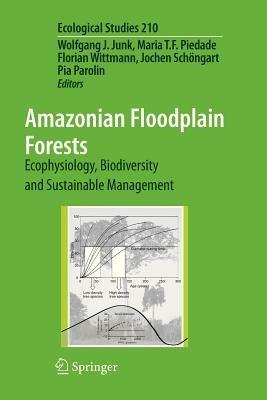Amazonian Floodplain Forests: Ecophysiology, Biodiversity and Sustainable Management
Central Amazonian floodplain forests are an unique and endangered ecosystem. The forests grow in areas that are annually flooded by large rivers during mean periods of up to 8 months and at depths of up to 10 m. Despite this severe stress, these forests consist of over 1,000 species and are by far the most species-rich floodplain forests worldwide. The trees show a broad range of morphological, anatomical, physiological, and phenological adaptations that enable them not only to survive the adverse environmental conditions, but also to produce large amounts of biomass when the nutrient levels in water and soils are sufficiently high. This is the case in the floodplains of white-water rivers, which are used for fisheries, agriculture, and cattle-ranching but which also have a high potential for the production of timber and non-timber products, when adequately managed. Latest research on ecophysiology gives insight how tree species adapt to the oscillating flood-pulse focusing on their photosynthesis, respiration, sap flow, biochemistry, phenology, wood and leave anatomy, root morphology and functioning, fruit chemistry, seed germination, seedling establishment, nitrogen fixation and genetic variability. Based on tree ages, lifetime growth rates and net primary production, new concepts are developed to improve the sustainability of traditional forest managements in the background of an integrated natural resource management. This is the first integrative book on the functioning and ecologically oriented use of floodplain forests in the tropics and sub-tropics.It provides fundamental knowledge for scientist, students, foresters and other professionals on their distribution, evolution and phytogeography. “This book is an excellent testimony to the interdisciplinary collaboration of a group of very dedicated scientists to unravel the functioning of the Amazonian Floodplain forests. They have brought together a highly valuable contribution on the distribution,ecology, primary production, ecophysiology, typology, biodiversity, and human use of these forests offering recommendations for sustainable management and future projects in science and development of these unique wetland ecosystems. It lays a solid scientific foundation for wetland ecologists, foresters, environmentalists, wetland managers, and all those interested in sustainable management in the tropics and subtropics.” Brij Gopal, Executive Vice President International Society for Limnology (SIL).
-
Curatore:
-
Editore:
-
Collana:Ecological Studies
-
Anno:2012
-
Rilegatura:Paperback / softback
Le schede prodotto sono aggiornate in conformità al Regolamento UE 988/2023. Laddove ci fossero taluni dati non disponibili per ragioni indipendenti da Feltrinelli, vi informiamo che stiamo compiendo ogni ragionevole sforzo per inserirli. Vi invitiamo a controllare periodicamente il sito www.lafeltrinelli.it per eventuali novità e aggiornamenti.
Per le vendite di prodotti da terze parti, ciascun venditore si assume la piena e diretta responsabilità per la commercializzazione del prodotto e per la sua conformità al Regolamento UE 988/2023, nonché alle normative nazionali ed europee vigenti.
Per informazioni sulla sicurezza dei prodotti, contattare productsafety@feltrinelli.it



